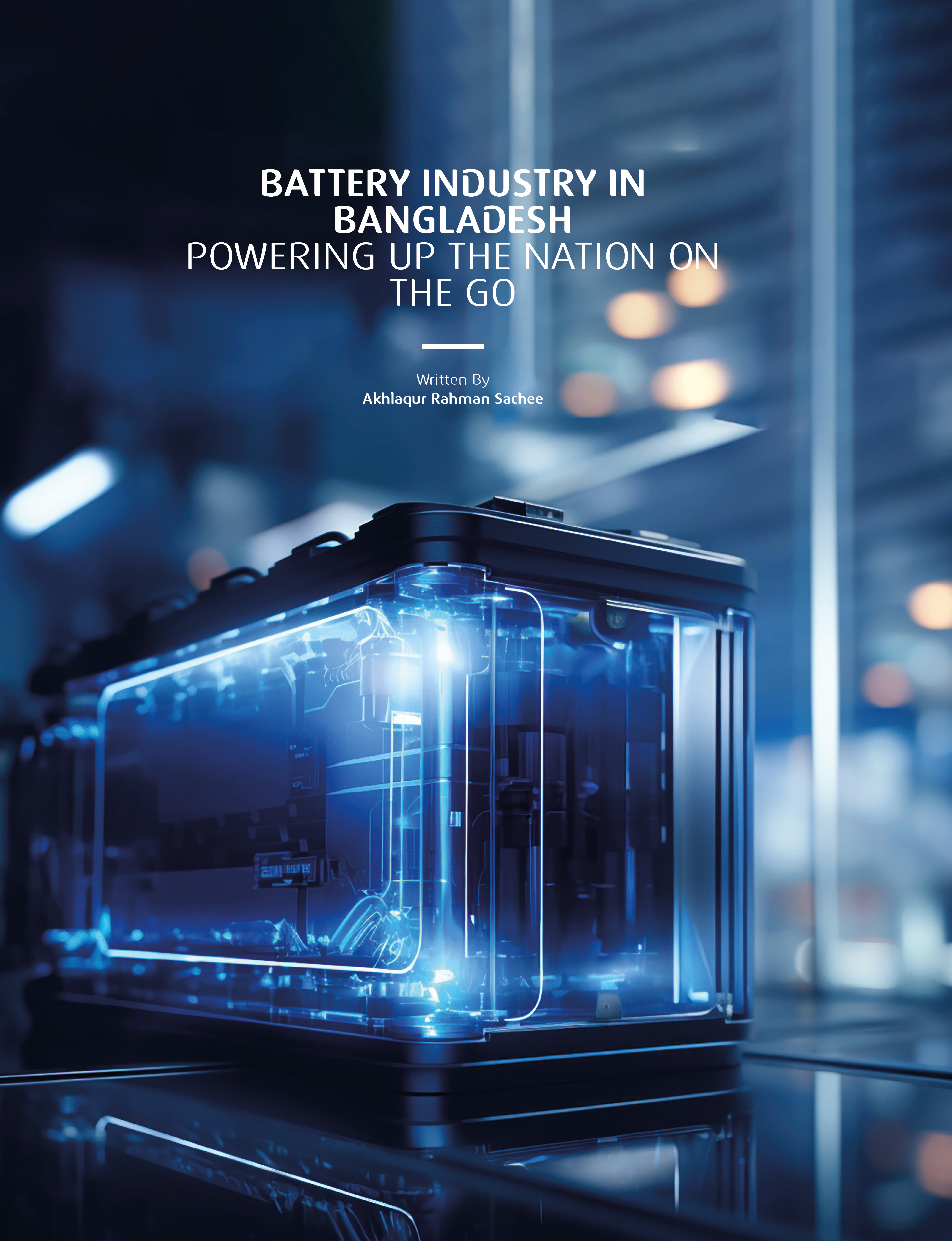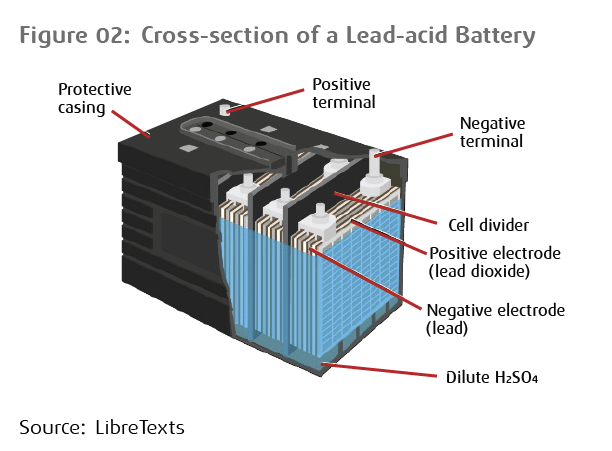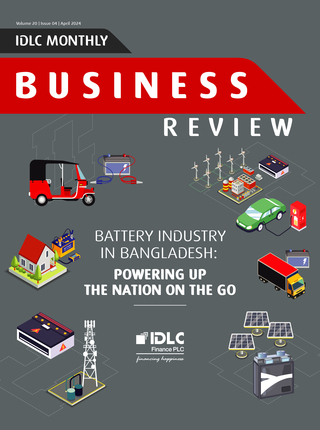
Battery Industry in Bangladesh: Powering Up the Nation on the Go
Akhlaqur Rahman Sachee
From the smartphones in our hands to the vehicles moving on the streets, anything that requires an energy carrier on the go is being powered up by batteries. Without batteries, smartphones would have been just expensive paperweights, clocks would not have been ticking, starter motors would not have gotten the engines in the vehicles started, solar panels would have failed to deliver uninterrupted supply of electricity in the absence of sunlight, telecommunications would have been significantly disrupted, and emergency power backups like Instant Power Supply (IPS) and Uninterrupted Power Supply (UPS) would have never been a possibility. With the growing adoption of electric vehicles and renewable energy sources such as solar, the demand for batteries is expected to only go up in the near future. However, the aforementioned purposes require different variants of batteries, including dry-cell batteries, lead-acid batteries, lithium batteries, and so on, which are of different technologies, and different chemical reactions take place inside the batteries to generate electricity. Among them, lead-acid batteries are used for most of the applications in the context of Bangladesh.
Lead-acid Battery Industry in Bangladesh
The size of the lead-acid battery industry in Bangladesh is more than BDT 10,000 crore, according to a report published by The Business Standard. The Business Post stated that the size of the industry has been multiplied three to four times in the last ten years. In terms of the number of units, the market players are capable of producing more than 40 lakh units of batteries every year. The pioneer in the local lead-acid battery industry is Rahimafrooz Group, which was incorporated in 1954. The concern first produced industrial batteries in 1985. Currently, Rahimafrooz Batteries Limited is the largest lead-acid battery manufacturer in the country, producing 200 different types of batteries for diversified applications. Also, there are two more concerns under the umbrella of Rahimafrooz Group, named Rahimafrooz Globatt Limited and Rahimafrooz Accumulators Limited. These concerns produce specialized batteries for vehicles and industrial applications. Alongside, there are more than 25 local manufacturers in Bangladesh producing batteries for solar panel systems, easy bikes, battery-run rickshaws, passenger transports, commercial vehicles, IPS systems, UPS systems, telecommunication towers, and so on. Navana Battery, Hamko Battery, Panna Battery, General Battery, Rimso Battery, Rangs, etc. are some of the prominent names in the lead-acid battery manufacturing industry in Bangladesh. The industry has employed more than 1 lakh people, directly or indirectly.
The lead-acid battery industry in Bangladesh is expected to experience a Compound Annual Growth Rate (CAGR) of more than 3% during the forecast period of 2022 to 2027, as per a report by Mordor Intelligence. With the decreasing price of lithium batteries and the increasing adoption of electric vehicles, which primarily use lithium batteries, the growth of the lead-acid battery industry is expected to slow down.
In the context of Bangladesh, the major portion of the demand for lead-acid batteries comes from battery-run three-wheelers, which are known as easy bikes. Battery-run rickshaws also fall into this category. A report by The Business Standard states that the number of easy bikes on the streets of Bangladesh has already exceeded 30 lakh. As policymakers are planning to regularise this mode of transport with the introduction of safer designs of vehicles and licencing procedures, the number of easy bikes and battery-run rickshaws will go up in the future. On top of that, easy bikes usually require five lead-acid batteries to run, and these batteries last much less than a year, generating recurring sales for the lead-acid battery manufacturers. According to an industry expert, these three-wheelers currently consume nearly 60% of the lead-acid batteries produced in the country.
Passenger cars and commercial cars using combustion engines require lead-acid batteries too. These vehicles are generating approximately 20% of the total demand for batteries. On the other hand, IPS, UPS, solar panels, telecommunication towers, etc. account for roughly 15% of the total demand. Rest 5% goes to other special purposes.

Broadly, the lead-acid batteries available in Bangladesh can be categorised into two types: flooded batteries and sealed batteries. Flooded batteries have removable caps that can be opened to refill distilled water, whereas sealed batteries are mostly maintenance-free. On the other hand, in terms of applications, lead-acid batteries can be divided into stationary batteries and mobile batteries. Stationary batteries are those used in solar panels, IPS, UPS, telecommunication towers, and so on, and mobile batteries are those used in automotives.
How a Lead-acid Battery Works
From the cross-sectional view of a lead-acid battery, it can be observed that there are two electrodes immersed in an electrolyte in a protective casing. The positive electrode is made of lead dioxide, and the negative electrode is made of lead. Each cell in a lead-acid battery produces 2 volts, and six cells produce 12 volts altogether. The electrolyte usually consists of 35% sulfuric acid and 65% water.

Approximately 50% of the raw materials required to produce lead-acid batteries are imported from countries like Malaysia, Singapore, China, South Korea, Thailand, India, and so on. The rest of the materials are sourced locally through recycling, mostly.
Export Outlook of the Battery Industry
In the last five fiscal years, around USD 29 million worth of lead-acid batteries were exported from the country on average. In terms of Harmonised System Codes (HS Codes), 850710 represents lead-acid accumulators for starting piston engines, and 850720 represents lead-acid accumulators (excl. for starting piston engines). Other than lead-acid batteries, the country also exports parts in small quantities. In FY2022-23, USD 28.50 million worth of lead-acid batteries were exported from the country. The major export destinations were the United Arab Emirates, Oman, Saudi Arabia, Kuwait, Nepal, Qatar, Australia, Malaysia, India, South Korea, Indonesia, and so on. The majority of the export revenues were earned by Rahimafrooz, which pioneered exporting batteries in 1992.

Recycling and Environmental Hazards
Battery Rescue states that 97% of a lead-acid battery can be recycled if done in a proper manner. Most of the components of lead-acid batteries, including lead plates, electrode separators, protective casings, etc., can be recycled. However, the acid must be neutralised before being released into the environment, and other wastes must be treated in regulated manners with the help of air treatment plants and effluent treatment plants. According to a report published by The Business Standard, 30 lakh easy bikes and battery-run rickshaws on the streets are generating 1.80 lakh metric tonnes of used lead-acid batteries every year. The unregulated facilities where lead-acid batteries are dismantled are locally known as ‘Bhatti’. Currently, there are 800 bhattis in operations without any clearance certificate from the Department of Environment (DoE). These bhattis pollute the land, water, and air in the process of recycling. The DoE requires the users of the lead-acid batteries to return those to the sellers after use. As per the rules, the manufacturers must collect the used batteries and recycle those themselves or get those recycled by compliant recyclers. However, there are more than 100 brands of lead-acid batteries available on the market that do not have certificates from Bangladesh Standards and Testing Institution. Manufacturers of these brands rely on these bhattis for recycled leads.
Alongside the environmental impacts, the adverse impact on the health of the workers of these bhattis is alarming. These workers have been found to have blood lead levels ranging from 66 to 78 micrograms per deciliter, whereas the World Health Organization recommends that lead exposure be terminated once someone is found to have a lead concentration of more than 5 micrograms per deciliter. Such high blood lead levels among the workers of bhattis will ultimately result in kidney failure.
Challenges Forward
The lead-acid battery industry may face transformations with the introduction of local production of lithium batteries. As a part of this endeavour, Bangladesh Lithium Battery Limited is constructing a manufacturing plant at Mirsarai, Chattogram, with an annual capacity of 1 gigawatt hour. The project requires an investment of BDT 600 crore to be operational, and it has already availed a syndicated term loan facility of BDT 332.6 crore, where Eastern Bank PLC. is the lead arranger.
The policymakers are planning to popularise electric vehicles among the masses, and hybrid vehicles are already popular in the country. These vehicles use lithium batteries. However, this is a prospective market for the local lithium battery industry. A major existing market, approximately 60% of the lead-acid battery market, which comprises easy-bikes and battery-run rickshaws, may become exposed to the risk of being captured by the lithium battery industry, as lithium batteries last longer, weigh less, require less time to recharge, and offer better mileage in comparison to lead-acid batteries. However, lithium batteries have drawbacks too. These batteries cost more, possess a higher risk of catching fire, offer less resale value, and require a more expensive recycling process in comparison to lead-acid batteries. Also, the installation of lithium batteries and replacing the lead-acid batteries will require easy bike and battery-run rickshaw owners to replace the charging systems and may require changes to the vehicle designs.
Alongside, 65% of the local demand is being served by Chinese companies. Allegations regarding unregulated operations and tax evasions have been heard against some Chinese companies producing lead-acid batteries. As a result, regulated local manufacturers struggle to compete with these Chinese companies in terms of pricing.
Lastly, the rising dollar price has affected the industry adversely. As around 50% of the raw materials required to produce lead-acid batteries are imported, the costs of manufacturing have surged. Also, finance costs have risen as opening LCs (Letters of Credit) these days requires a 100% cash margin or more.
The local lead-acid battery industry has served the country for decades while earning export revenues for the country. If policymakers come up with the required policy support to create a level playing field, the projected transitions in the industry will be a win-win scenario for every participant in the battery industry as a whole. Moreover, the government should come forward to bring the unregulated battery manufacturers under regulations so that environmental and health risks can be minimised and the government can earn tax revenues from these manufacturers.
The author is working as a senior credit analyst at IDLC Finance PLC. and can be reached at akhlaqur@idlc.com.

Battery Industry in Bangladesh: Powering Up the Nation on the Go
The lead-acid battery industry, which has grown three to four times in the last decade and is valued at BDT 10,000 crore currently, serves a wide variety of purposes without which portability and mobility would have never been a possibility. Solar panels, easy bikes, battery-run rickshaws, passenger transports, commercial vehicles, IPS, UPS, and telecommunication towers—all these either run on batteries or require batteries as power storage. The fact that the lead-acid battery industry exported around USD 29 million worth of batteries on average in the last five fiscal years makes the industry a potential contributor to our foreign exchange earnings as well.
It is not unknown that the industry faces controversies due to the unregulated manufacturing and recycling operations of some market players. Just like many other industries dependent on imports of raw materials, the rising dollar price has affected the industry adversely. On top of that, the potential emergence of the local lithium battery industry may bring additional challenges. However, policymakers should come forward to create a conducive business environment for this decades-old industry and regularise the unregulated players to minimise the associated environmental and health risks and boost the country’s tax revenues.
Md. Shah Jalal
Editor
IDLC Monthly Business Review
Download View